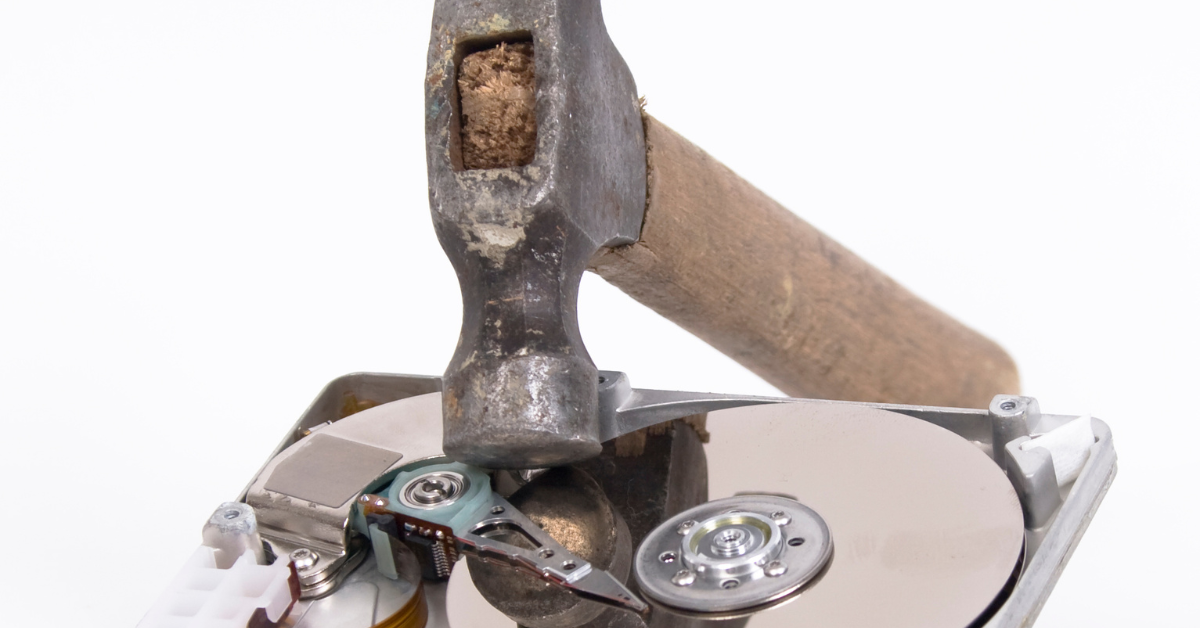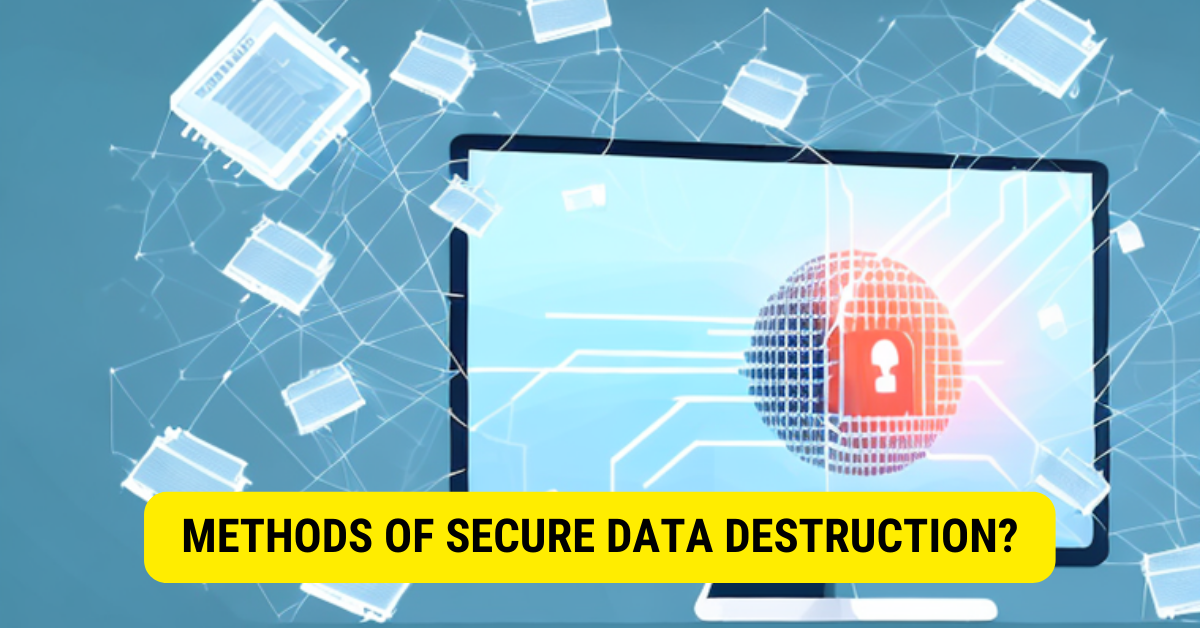The main goal of secure data destruction is to permanently and irreversibly remove sensitive or confidential information from storage devices or systems to prevent unauthorized access, data breaches, or information leakage
In today’s digital world, where data is constantly being generated and shared, the main goal of secure data destruction is to ensure the privacy, confidentiality, and integrity of sensitive information. Understanding the concept of data destruction is crucial in implementing effective strategies to protect individuals and organizations from potential data breaches and unauthorized access.
Understanding the Concept of Data Destruction

Data destruction, as the name suggests, refers to permanently and securely erasing or destroying data to prevent it from being accessed, recovered, or used in any unauthorized manner. It completely eradicates data from any storage medium, including traditional hard drives, solid-state drives, tapes, and mobile devices.
Regarding data destruction, various methods can be employed, each with its level of effectiveness and security. The choice of method depends on factors such as the type of storage medium, the sensitivity of the data, and the level of security required.
One data destruction method is physical destruction, which involves physically damaging the storage medium to the point where the data becomes irretrievable. This can be done through shredding, crushing, or Incineration. Physical destruction ensures that the data cannot be recovered through any means, providing high security.
Another data destruction method is digital wiping, also known as data erasure. This process involves overwriting the data on the storage medium with random or predefined patterns, making it impossible to recover the original data. Digital wiping can be done using specialized software or hardware tools that ensure complete and secure data removal.
Defining Data Destruction
Data destruction can be defined as the systematic and irreversible removal of data from a storage device, rendering it unreadable and unrecoverable. This process occurs through physical destruction or digital wiping, depending on the chosen method.
Physical destruction involves physically damaging the storage medium, making retrieving any data from it impossible. This can be done through methods such as shredding, where the storage medium is cut into small pieces, or crushing, where it is subjected to extreme pressure until it is destroyed. Incineration is another method that involves burning the storage medium to ashes, ensuring no data can be recovered.
Digital wiping, on the other hand, involves overwriting the data on the storage medium with random or predefined patterns. This process ensures that the original data is erased and replaced with meaningless data, making it impossible to recover the original information. Digital wiping can be done using specialized software that performs multiple passes of data overwriting, ensuring the complete removal of all traces of the original data.
The Importance of Data Destruction in Today’s Digital World
In the digital era, where data breaches and cyber attacks are on the rise, ensuring the secure destruction of data has become paramount. The consequences of a data breach can be severe, including financial loss, reputational damage, and potential legal penalties. Therefore, organizations and individuals must prioritize secure data destruction to protect themselves and their stakeholders.
Secure data destruction helps prevent unauthorized access to sensitive information and ensures compliance with data protection regulations and standards. Many countries and industries have specific requirements for data destruction, and failure to comply can result in severe consequences.
Furthermore, secure data destruction is essential for maintaining customer trust and confidence. Customers expect organizations to handle their data responsibly and securely. Organizations can demonstrate their commitment to protecting customer privacy and safeguarding sensitive information by implementing proper data destruction practices.
It is worth noting that data destruction is not limited to organizations alone. Individuals are also responsible for ensuring the secure disposal of their personal data. This includes deleting data from old devices before selling or disposing of them and securely erasing data from digital storage mediums such as USB drives and memory cards.
Data destruction is crucial in today’s digital world. It involves the permanent and secure erasure or destruction of data to prevent unauthorized access and protect sensitive information. Organizations and individuals can mitigate the risks associated with data breaches and ensure compliance with data protection regulations by employing proper data destruction methods.
The Main Goal of Secure Data Destruction
The main goal of secure data destruction is multifaceted, encompassing various factors that contribute to safeguarding confidential information.
When it comes to secure data destruction, the stakes are high. Organizations need to ensure that sensitive and personal information remains private and confidential. This means going beyond simply deleting files or formatting hard drives. Secure data destruction involves thorough and comprehensive methods that make extracting any meaningful information from the destroyed data virtually impossible.
Ensuring privacy and confidentiality is not only a matter of following recommended practices but also a legal and ethical obligation. Organizations that handle sensitive data, such as healthcare providers or financial institutions, are obligated to comply with strict legal and regulatory requirements. These regulations are in place to safeguard individuals’ privacy and prevent unauthorized access to their personal information.
Adhering to legal and regulatory requirements is crucial for organizations across various industries. Failing to comply with these regulations can lead to severe consequences, including financial penalties, legal repercussions, and damage to reputation. Secure data destruction plays a vital role in ensuring compliance and protecting organizations from potential risks.
Unauthorized access to data is one of the most significant threats organizations face today. Data breaches can result in severe consequences, including financial losses, harm to reputation, and loss of customer trust. Secure data destruction minimizes the risk of data breaches by eliminating any possibility of data recovery.
Consider a scenario where a company is upgrading its IT infrastructure and disposing of old computers. Without proper data destruction, someone with malicious intent could potentially retrieve sensitive information from these discarded devices. However, through secure data destruction methods that render the data unreadable and unrecoverable, organizations can reduce the likelihood of sensitive information falling into the wrong hands.
Secure data destruction encompasses various techniques, including physically destroying storage media, degaussing, and secure erasure. These methods ensure that the data becomes irretrievable and cannot be reconstructed, even through advanced data recovery techniques.
Secure data destruction goes beyond simply deleting files or formatting hard drives. It involves a comprehensive process that guarantees privacy, confidentiality, compliance with legal and regulatory requirements, and protection against unauthorized access and data breaches. By implementing secure data destruction practices, organizations can safeguard sensitive information and maintain the trust of their customers and stakeholders.
Methods of Secure Data Destruction

Regarding secure data destruction, various methods are available, each with strengths and weaknesses. These methods ensure that sensitive information is completely and irreversibly removed from storage media, preventing unauthorized access or retrieval.
Physical Destruction of Data
Physical destruction is one of the most foolproof methods for ensuring data destruction. This method involves physically damaging the storage medium to render the data irretrievable. Several techniques are used in physical destruction, such as shredding or pulverizing hard drives, crushing or melting optical discs, or even incinerating tapes.
Shredding, often used for hard drives, involves feeding the storage medium through a specialized machine that cuts it into small pieces, making data recovery virtually impossible. On the other hand, pulverizing uses powerful machinery to crush the storage medium into tiny fragments, ensuring that no trace of the original data remains. For optical discs, melting is common, where the disc is exposed to high temperatures until it becomes liquid, destroying the data stored on its surface. Incineration, often used for tapes, involves subjecting the storage medium to intense heat until completely burned, leaving no chance for data recovery.
Digital Data Wiping
Digital data wiping is another effective method of secure data destruction. This method involves overwriting the storage medium with random or predetermined patterns, effectively erasing the existing data. Data wiping software is commonly used for hard drives and solid state drives, ensuring that all sectors of the storage device are overwritten multiple times. Doing so removes any traces of the original data, making it virtually impossible to recover.
Data wiping software follows specific algorithms to ensure the entire storage medium is overwritten. These algorithms may include patterns of ones and zeros or even more complex patterns designed to make data recovery extremely difficult. The number of times the data is overwritten can differ depending on the level of security required, with some methods overwriting the data multiple times to ensure complete erasure.
Degaussing: A Method of Magnetic Destruction
Primarily used for magnetic storage media, such as tapes and floppy disks, degaussing is a method that involves applying a strong magnetic field to the storage device. This magnetic field disrupts the magnetic structure of the storage medium, effectively erasing the magnetically stored data. Degaussing renders the data unrecoverable, as the original magnetic patterns are destroyed.
During the degaussing process, the storage medium is exposed to a powerful degausser, which generates a strong electromagnetic field. This field neutralizes the magnetic properties of the storage medium, effectively wiping out any stored data. Degaussing is often used in high-security environments where data destruction is necessary to prevent unauthorized access or retrieval.
It is important to note that while degaussing is highly effective for magnetic storage media, it is unsuitable for all storage devices. For example, solid-state drives (SSDs) do not rely on magnetic storage and cannot be degaussed. Alternative methods like physical destruction or digital data wiping should be employed in such cases.
Overall, the methods of secure data destruction mentioned above provide organizations and individuals with reliable options to ensure the complete removal of sensitive information. By employing these methods, the risk of data breaches or unauthorized access to confidential data is significantly reduced, helping to protect privacy and maintain data security.
Best Practices for Secure Data Destruction
Secure data destruction requires careful planning and adherence to established best practices.
Establishing a Data Destruction Policy

Organizations should develop a comprehensive data destruction policy that outlines the procedures and methods to be followed. This policy should define the responsibilities of individuals involved in the data destruction process and establish clear guidelines for destroying different types of data and storage media.
Regular Auditing and Monitoring

Regular auditing and monitoring of data destruction practices are essential to ensure adherence to established policies and the effectiveness of the chosen methods. By regularly reviewing data destruction processes, organizations can identify potential gaps or areas for improvement and take appropriate action.
Employing Certified Data Destruction Services
Employing certified data destruction services is recommended for organizations without the resources or expertise to carry out data destruction in-house. These services specialize in secure data destruction and follow industry best practices to ensure complete and irreversible data removal. Engaging certified services provides peace of mind and minimizes the risk of data breaches or unauthorized access.
Key Takeaways
- The main goal of secure data destruction is to permanently and irreversibly remove sensitive or confidential data from storage devices or media.
- Secure data destruction helps prevent unauthorized access, data breaches, identity theft, and the misuse of sensitive information.
- It ensures compliance with data protection regulations and industry standards.
- Secure data destruction techniques vary depending on the type of storage media, such as hard drives, solid-state drives (SSDs), magnetic tapes, or optical discs.
- Common methods of secure data destruction include physical destruction (shredding or disintegration), degaussing (for magnetic media), software-based erasure (using specialized tools or utilities), and secure wiping (overwriting data multiple times).
- Organizations should establish clear data destruction policies, procedures, and documentation to maintain an audit trail of data disposal activities.
- Training personnel or certified data destruction service providers should perform secure data destruction.
- Verification and validation of data destruction should be conducted to ensure the effectiveness and completion of the process.
FAQs
Who needs to perform secure data destruction?
Any individual, organization, or business that handles sensitive information has a responsibility to perform secure data destruction. This includes government agencies, healthcare providers, financial institutions, and businesses that handle customer or employee data.
Are there legal requirements for secure data destruction?
Yes, in many jurisdictions, there are legal requirements and regulations that mandate secure data destruction practices. These regulations aim to protect individuals’ privacy and ensure that businesses handle data responsibly and securely.
What are the benefits of using professional data destruction services?
Professional data destruction services have the expertise, specialized equipment, and knowledge of compliance requirements to ensure secure and thorough data destruction. They offer a reliable and efficient solution, providing peace of mind that sensitive information is properly handled and disposed of.
Can data be recovered after secure data destruction?
No, the goal of secure data destruction is to render the information unrecoverable. When implemented correctly, data should be permanently erased or destroyed, making it extremely difficult or impossible to retrieve any meaningful data from the storage devices.
Conclusion
In conclusion, the main goal of secure data destruction is to protect privacy, maintain confidentiality, comply with legal and regulatory requirements, and prevent unauthorized access and data breaches. By understanding the concept of data destruction and implementing best practices, individuals and organizations can effectively safeguard sensitive information in today’s digital landscape.
